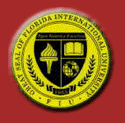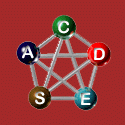



Here is a list of selected journals and conferences:
- Shu-Ching Chen and R. L. Kashyap, "A Spatio-Temporal Semantic Model for Multimedia Database Systems and Multimedia Information Systems," IEEE Trans. on Knowledge and Data Engineering, accepted for publication, 2000.
- Shu-Ching Chen, Srinivas Sista, Mei-Ling Shyu, and R. L. Kashyap, "Augmented Transition Networks as Video Browsing Models for Multimedia Databases and Multimedia Information Systems," 11th IEEE International Conference on Tools with Artificial Intelligence (ICTAI'99), pp. 175-182, November 9-11, 1999, Chicago, IL, U.S.A.
Abstract:In an interactive multimedia information system, users should have the flexibility to browse and choose various scenarios they want to see. This means that two-way communications should be captured by the conceptual model. Digital video has gained increasing popularity in many multimedia applications. Instead of sequential access to the video contents, the structuring and modeling of video data so that users can quickly and easily browse and retrieve interesting materials becomes an important issue in designing multimedia information systems. An abstract semantic model called the augmented transition network (ATN), which can model video data and user interactions, is proposed in this paper. An ATN and its subnetworks can model video data based on different granularities such as scenes, shots and key frames. Multimedia input strings are used as inputs for ATNs. The details of how to use multimedia input strings to model video data are also discussed. Key frame selection is based on temporal and spatial relations of semantic objects in each shot. The temporal and spatial relations of semantic objects are captured from our proposed unsupervised video segmentation method which considers the problem of partitioning each frame as a joint estimation of the partition and class parameter variables. Unlike existing semantic models which only model multimedia presentation, multimedia database searching, or browsing, ATNs together with multimedia input strings can model these three in one framework.
Download (Postscript format - 911k) - Shu-Ching Chen, Mei-Ling Shyu, and R. L. Kashyap, "Multimedia Presentation Using Augmented Transition Networks and Multimedia Input Strings," ISCA 12th International Conference On Computer Applications In Industry And Engineering (CAINE-99), pp. 58-61, November 4-6, 1999, Atlanta, Georgia U.S.A.
Abstract:An abstract semantic model called augmented transition network (ATN) to model multimedia presentations is proposed. An ATN is created based on a multimedia input string and it consists of a set of states and directed arcs. The advantages to using a multimedia input string to generate an ATN are its simplicity and ease of modification. The arc symbols of subnetworks represent the temporal and spatial relations of semantic objects. The separated condition/action table is used to control synchronization and quality of service of the multimedia presentation at both the coarse-grained and fine-grained levels. The formal proof of any multimedia input string that has the corresponding ATN is presented in this paper. Based on this proof, it shows that together ATNs and multimedia input string, multimedia presentations can be modeled.
Download (Postscript format - 126k) - Mei-Ling Shyu, Shu-Ching Chen, and R. L. Kashyap, "Information Retrieval Using Markov Model Mediators in Multimedia Database Systems," 1998 International Symposium on Multimedia Information Processing, pp. 237-242, Dec. 14-16, 1998.
Abstract:Recent progress in high-speed communication networks, large capacity storage devices, digitalized media, and data compression technologies have resulted in a variety of multimedia applications using the integration of text, images, audio, graphics, animation, and full-motion video. For traditional text-based database management systems, data access and manipulation have advanced considerably. However, for multimedia database systems, information retrieval is more difficult than that of the conventional data since it is necessary to incorporate diverse media with diverse characteristics. The need for information retrieval in multimedia database systems increases proportional to the continuous growth of diverse information sources and the proliferation of independent but related user applications. Therefore, the ability to query the databases and to locate specific information directly as needed is important for multimedia database systems. For this purpose, a mathematical sound framework, called Markov model mediators (MMMs) which employ the principle of Markov models and the concept of mediators, is introduced in this paper. The proposed MMM mechanism performs information retrieval via a stochastic process which generates a list of possible state sequences with respect to a given query and indicates which particular media objects to query.
Download (Postscript format - 161k) - Shu-Ching Chen and R. L. Kashyap, "Empirical Studies of Multimedia Semantic Models for Multimedia Presentations," 13th International Conference on Computer and Their Applications, pp. 226-229, March 25-27, 1998.
Abstract:Empirical studies of an abstract semantic model, augmented transition network (ATN), with Object Composition Petri Net (OCPN) to model multimedia presentations are performed in this paper. An ATN consists of a set of states and directed arcs and uses a regular expression as its input. The advantages to use a regular expression are its simplicity and ease of modification. Simulation experiments to compare ATN and OCPN are performed in this paper. The results show that ATN requires fewer nodes and arcs to represent a multimedia presentation than OCPN does. These results indicate ATN handles on-line multimedia presentations more efficient and requires less precious main memory space.
Download (Postscript format - 144k) - Shu-Ching Chen and R. L. Kashyap, "Temporal and Spatial Semantic Models for Multimedia Presentations," 1997 International Symposium on Multimedia Information Processing, pp. 441-446, Dec. 11-13, 1997.
Abstract:An abstract semantic model based on augmented transition network (ATN) to model multimedia presentations is presented in this paper. The inputs for ATNs are modeled by regular expressions. Regular expressions provide an efficient means for iconic indexing of the temporal/spatial relations of media streams and semantic objects. An ATN and its subnetworks are used to represent the appearing sequence of media streams and semantic objects. The arc label is a substring of a regular expression. In this design, a presentation is driven by a regular expression. User interactions, loops, and embedded presentations in multimedia presentations are also provided in ATNs.
Download (Postscript format - 144k)
For problems or questions about this web, contact webmaster@cadse.cs.fiu.edu